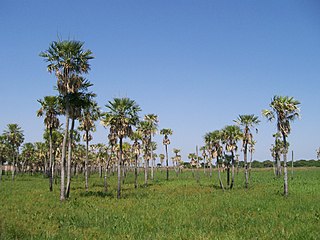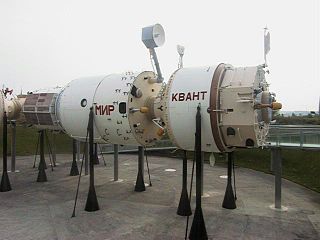Related Research Articles

A sounding rocket or rocketsonde, sometimes called a research rocket or a suborbital rocket, is an instrument-carrying rocket designed to take measurements and perform scientific experiments during its sub-orbital flight. The rockets are used to launch instruments from 48 to 145 km above the surface of the Earth, the altitude generally between weather balloons and satellites; the maximum altitude for balloons is about 40 km and the minimum for satellites is approximately 121 km. Certain sounding rockets have an apogee between 1,000 and 1,500 km, such as the Black Brant X and XII, which is the maximum apogee of their class. Sounding rockets often use military surplus rocket motors. NASA routinely flies the Terrier Mk 70 boosted Improved Orion, lifting 270–450-kg (600–1,000-pound) payloads into the exoatmospheric region between 97 and 201 km.
Las Palmas, most commonly refers to Las Palmas de Gran Canaria, a city in the Canary Islands, Spain.

Chaco, officially the Province of Chaco, is one of the 23 provinces in Argentina. Its capital and largest city, is Resistencia. It is located in the north-east of the country.

The Éridan is a two-stage French sounding rocket, which results from the use of the Stromboli engine for the first and second stages.

Unión Deportiva Las Palmas, commonly referred to as UD Las Palmas or Las Palmas, is a professional football club based in Las Palmas de Gran Canaria, Canary Islands, Spain. The club competes in La Liga, the top division in the Spanish football league system. Nicknamed Los Amarillos, the club was founded on 22 August 1949 as a result of a merger between five clubs in the Canary region. The club initially played in the Estadio Insular before hosting their home matches at the Estadio de Gran Canaria in 2003.
Mélanie is a French solid rocket motor, 16 cm in diameter, initially used as first stage of the Monica rocket.

Astérix or A-1 is the first French satellite. It was launched on 26 November 1965 by a Diamant A rocket from the CIEES launch site at Hammaguir, Algeria. With Astérix, France became the sixth country to have an artificial satellite and the third country to launch a satellite on its own rocket. Its main purpose was to test the Diamant launcher, though it was also designed to study the ionosphere. Astérix continues to orbit Earth as of 2023 and is expected to remain in orbit for centuries.

The National Space Activities Commission is the civilian agency of the government of Argentina in charge of the national space programme.

Tartagal is a tropical city in northern Argentina, in the province of Salta. It is located in the northeast of the province, within the General José de San Martín Department, of which it is the capital. It is located in the Yungas jungle, at the foot of the sub-Andean mountain ranges to the west and the Salta plains to the east. This location gives it a wide variety of flora and fauna, and its territory is home to eight indigenous communities. It stands out for the large density of large trees in its streets and squares, such as mangoes, algarrobos and lapachos. It is one of the few places in the world where the green macaw is not extinct in the wild.

The Cité de l'espace is a scientific discovery centre in France focused on spaceflight. It was opened in June 1997, and is located on the eastern outskirts of Toulouse. It was carried out on the initiative of the Town Hall of Toulouse with the participation of numerous partners such as the Regional Council of Midi-Pyrénées, the Ministries of Equipment, Transport, Defence, National Education, Research and Technology, the National Center for Space Studies (CNES), Météo-France, EADS, Astrium, among others. As of 2012, there had been more than four million visitors.
The French space program includes both civil and military spaceflight activities. It is the third oldest national space program in the world, after the Soviet and American space programs, and the largest space program in Europe.

Rohini is a series of sounding rockets developed by the Indian Space Research Organisation (ISRO) for meteorological and atmospheric study. These sounding rockets are capable of carrying payloads of 2 to 200 kilograms between altitudes of 100 to 500 kilometres. The ISRO currently uses RH-200, RH-300,Mk-II, RH-560 Mk-II and RH-560 Mk-III rockets, which are launched from the Thumba Equatorial Rocket Launching Station (TERLS) in Thumba and the Satish Dhawan Space Centre in Sriharikota.
CELPA (Mar Chiquita) also known as CELPA Atlántico (Centro de Experimentación y Lanzamiento de Proyectiles Autopropulsados) was a rocket launch site in Mar Chiquita, Argentina, north of Mar del Plata.

ARSAT-1 is a geostationary communications satellite operated by AR-SAT and built by the Argentine company INVAP. ARSAT-1 was launched into orbit on October 16, 2014, from French Guiana alongside Intelsat-30 satellite using an Ariane 5 rocket. It is expected to be located at 72° West longitude geostationary slot. ARSAT-1 is the first geostationary satellite built in Latin America. Total cost of the satellite is 270 million US dollars.

Payload Aerospace S.L. is a Spanish company developing two partially-reusable launch vehicles called Miura 1 and Miura 5.
Société d'étude et de réalisation d'engins balistiques or SÉREB was a French aviation company.
Starlette and Stella are nearly identical French geodetic and geophysical satellites. Starlette was launched on 6 February 1975 and Stella on 26 September 1993. Starlette was the first passive laser satellite developed.
CERESIle du Levant was a French suborbital rocket launch site, located at Ile du Levant, and active between 1956 and 1968. CERES played a pivotal role in testing a wide array of tactical missiles used in France, as well as conducting tests for sounding rockets on behalf of CNES and ESRO. Additionally, the center was involved in experiments with ONERA and SEREB experimental vehicles, solidifying its significance in the realm of missile research and testing.

The Titus sounding rocket was developed specifically by ONERA for observing the solar corona and conducting spectral analysis of the Sun's ultraviolet rays during the November 1966 solar eclipse in Argentina. The two-stage rocket, standing just over 11.5 meters tall and weighing 3045 kg without payload, could launch 400 kg to an altitude of 250 km.
The Centauro series is a family of Argentinian solid fuel sounding rockets developed by the Instituto de Investigaciones Aeronauticas y Espaciales (IIAE). This family includes Alfa, Beta, and Gamma Centauro.
References
- 1 2 "Argentina en la aventura espacial, el eclipse, un jalón para nuestra ciencia, cronicas del siglo pasado, 60s, sesentas, 70s, setentas, politica, nacional, musica, comentarios, historia, argentina, ensayos, fotos". www.magicasruinas.com.ar. Retrieved 2023-11-15.
- 1 2 "Las Palmas". Astronautix.com. Archived from the original on October 11, 2008. Retrieved 2016-01-09.
- 1 2 3 "Titus". www.astronautix.com. Retrieved 2023-11-14.
- 1 2 "La fusée Titus". Europespace. Retrieved 2023-11-14.
- ↑ "SEPR-739 with upper stages". Gunter's Space Page. Retrieved 2023-11-14.
- 1 2 "Fusées de l'ONERA". Les fusées en Europe. 2013-01-15. Archived from the original on 2013-01-15. Retrieved 2023-11-14.
- 1 2 3 4 Varnoteaux, Philippe (May 2016). "Il y a 50 ans, le CNES et l'ONERA effectuaient en Argentine la spectaculaire opération «Eclipse»" (PDF). Espace & Temps. Bulletin d’information de l’Institut Français d’Histoire de l’Espace. No. 17. Institut Français d’Histoire de l’Espace. pp. 10–19.